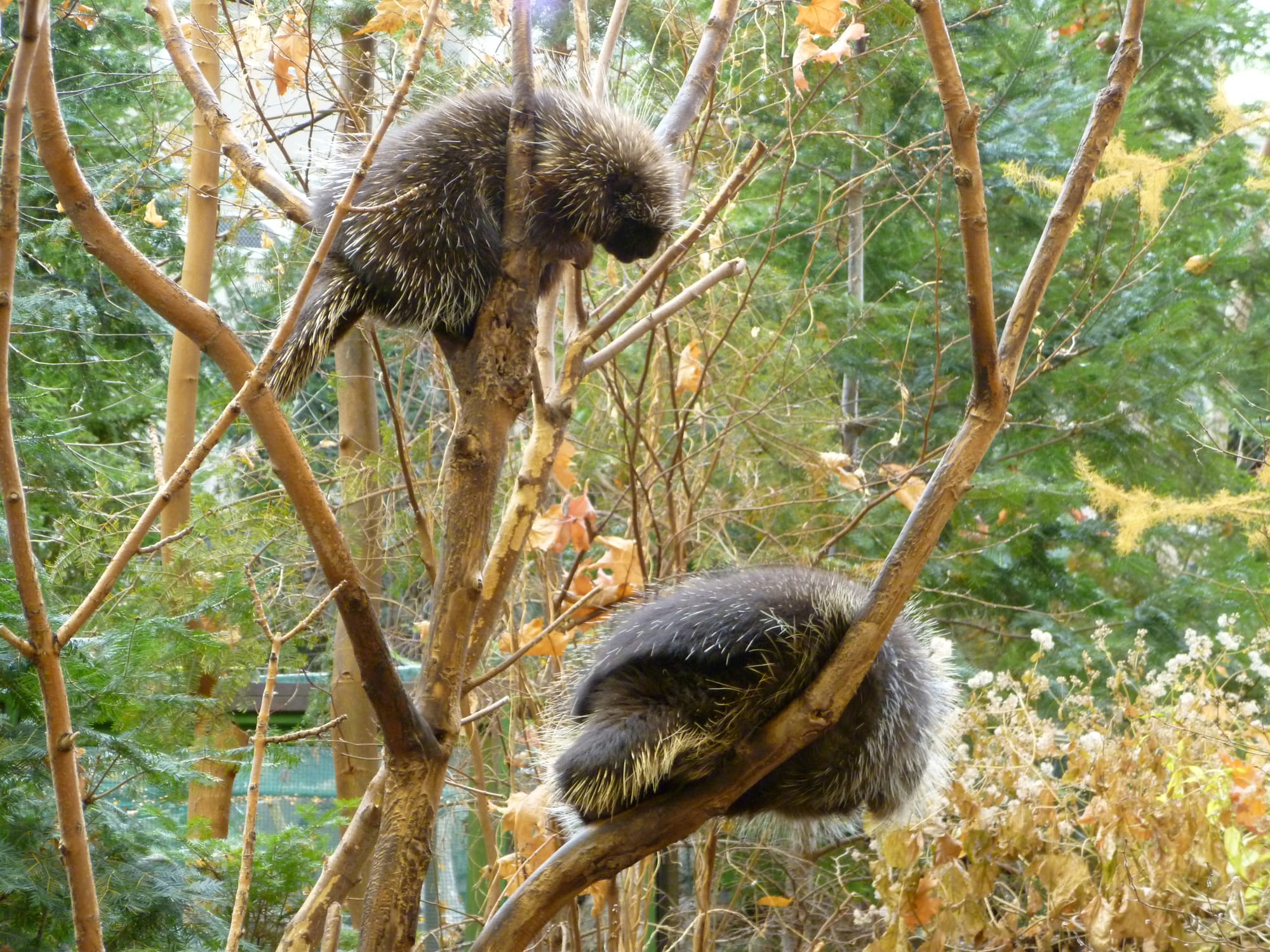Porcupines are easy to recognize but hard to find — so elusive, in fact, that few people have ever seen one in the wild.
Emilio Tripp, a wildlife manager and citizen of the Karuk Tribe in Northern California, might have been one of the lucky ones. On a nighttime drive with his father in the late 1990s, a ghostly silhouette flashed by the window. “That was my only time I’ve even thought I’ve seen one,” he recalled decades later. Tripp still can’t say for sure whether it was a kaschiip, the Karuk word for porcupine, but he holds on to the memory like a talisman.
The 43-year-old hasn’t seen another porcupine since. Porcupine encounters are rare among his tribe, and the few witnesses seem to fit a pattern: Almost all of them are elders, and they fondly remember an abundance of porcupines until the turn of this century. Now, each new sighting rings like an echo from the past: a carcass on the road; a midnight run-in. The tribe can’t help wondering: Where did all the porcupines go?
“Everyone’s concerned,” Tripp said. “If there were more (observations), we’d hear about it.”
The decline isn’t just in Northern California: Across the West, porcupines are vanishing. Wildlife scientists are racing to find where porcupines are still living, and why they’re disappearing. Others, including the Karuk Tribe, are already thinking ahead, charting ambitious plans to restore porcupines to their forests.
“Everyone’s concerned.”

PORCUPINES ARE WALKING PINCUSHIONS. Their permanently unkempt hairdo is actually a protective fortress of some 30,000 quills. But their body armor can be a liability, too — porcupines are known to accidentally quill themselves. “They’re big and dopey and slow,” said Tim Bean, an ecologist at California Polytechnic State University who has collared porcupines as part of his research. They waddle from tree to tree, usually at night, to snack on foliage or the nutrient-rich inner layer of bark.
But these large rodents are far from universally beloved. Their tree-gnawing habits damage lumber, and the timber industry has long regarded them as pests. Widespread poisoning and hunting campaigns took place throughout the 1900s in the U.S. Between 1957 and 1959, Vermont alone massacred over 10,800 porcupines. Forest Service officials in California declared open season on porcupines in 1950, claiming that the species would ultimately destroy pine forests.
Though state bounty programs had ended by 1979, porcupine numbers have not rebounded. Recent surveys by researchers in British Columbia, Arizona, western Montana and Northern California show that porcupines remain scarce in those regions today. Historically, porcupine populations haven’t been well-monitored, so scientists can’t say for sure whether they are still declining or simply haven’t recovered after decades of persecution.
But anecdotal evidence from those who recall when sightings were common is enough to ring alarm bells. Similar patterns appear to be playing out across the West: Veterinarians are treating fewer quilled pets, for example, and longtime rural homeowners have noticed fewer porcupines lurking in their backyards. Hikers’ accounts note that porcupines are harder to find than ever before. Some forest ecosystems are already showing the effects of losing an entire species from the food chain: In the Sierra Nevada, an endangered member of the weasel family called the fisher is suffering from lack of the protein porcupines once provided. As a result, the fishers are scrawnier and birth smaller litters in the Sierras than they do elsewhere.

Porcupines are culturally important to the Karuk Tribe, whose members weave quills into cultural and ceremonial items, such as baskets. But these days, the tribe imports quills more often than it harvests them. That’s more than just an inconvenience: Not being able to gather quills locally constitutes a form of lost connection between tribal members and their homelands. “It’s important for (porcupines) to be a part of our landscape. That’s part of why they’re chosen to be part of this ceremonial item,” Tripp said.
Erik Beever, an ecologist at the U.S. Geological Survey, worries that the great porcupine vanishing act points to a broader trend. Across the country, biodiversity is declining faster than scientists can track it. The porcupine might just be one example of what Beever calls “this silent erosion of animal abundance.” But no one really knows what’s going on. Beever said, “We’re wondering whether the species is either increasing or declining without anybody even knowing.”
“It’s important for (porcupines) to be a part of our landscape. That’s part of why they’re chosen to be part of this ceremonial item.”
SCIENTISTS ARE RACING TO fill this knowledge gap. Bean and his team combed through a century’s worth of public records to map porcupine distribution patterns in the Pacific Northwest. Roadkill databases, wildlife agency reports and citizen science hits revealed that porcupines are dwindling in conifer forests but popping up in nontraditional habitats, such as deserts and grasslands. Beever is now leading a similar study across the entire Western U.S.
Concerned scientists have several theories about why porcupines have not returned to their former stomping grounds. Illegal marijuana farms, which are often tucked away in forests, use rodenticides that kill many animals, including porcupines, while increased protections for apex predators like mountain lions may have inadvertently increased the decline of porcupines. On top of all this, porcupines have low reproduction rates, birthing only a single offspring at a time.
Understanding porcupine distribution isn’t easy. Porcupines are generalists, inhabiting a wide variety of forest types, so it’s challenging for researchers to know where to look. As herbivores, porcupines aren’t that easy to bait, either. Scientists have experimented with using brine-soaked wood blocks, peanut butter and even porcupine urine to coax the cautious critters toward cameras, but with only mixed success. In 34 years of both baited and unbaited camera surveys by the Central Sierra Environmental Resource Center in the Sierra Nevada, porcupines have only shown up three times.
“It’s a mystery,” said John Buckley, the center’s executive director. “We still don’t understand (why) they’re not reproducing and filling back in where there’s very little disturbance of their habitat, like Yosemite National Park.”

THE KARUK TRIBE IS EAGER to bring porcupines back. But first, the tribe needs to figure out where healthy populations may already exist. Years of camera trap surveys have turned up scant evidence of the creature’s presence; one area that Tripp considers a “hotspot” had photographed a single porcupine. “That’s how rare they are,” Tripp said. So Karuk biologists are considering other methods, including using trained dogs to conduct scat surveys.
Reintroducing the species would require a delicate balancing act. Porcupines are already scarce, and it’s unclear whether already-small source populations could afford to lose a few members to be reintroduced elsewhere. Still, Tripp feels like it’s time to act, since the ecosystem doesn’t appear to be healing on its own. “Things don’t seem to be getting better in over the course of my lifetime,” Tripp said.
Yet his actions betray some lingering optimism. Tripp, his wife and daughter still regularly attend basket-weaving events involving quills, doing their part to uphold the Karuk’s age-old traditions that honor the porcupine. It’s a small act of stubborn hope — that, perhaps in a few years, the tribe will be able to welcome the porcupine home.
This article first appeared on High Country News and is republished here under a Creative Commons Attribution-NonCommercial-NoDerivatives 4.0 International License.



